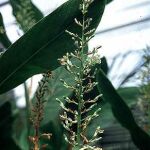| Common Name: |
Galangal |
| Other Names: |
Greater galingal, Siamese ginger |
| Botanical Name: |
Alpinia galanga |
| Genus: |
Alpinia |
| Family: |
Zingiberaceae |
| Cultivation: |
Well-drained, rich soil in partial shade with high humidity. Spider mite may attack plants under cover. |
| Propagation: |
By division of rhizomes as new growth begins. |
| Harvest: |
Rhizomes four to six years old are lifted at the end of the growing season and used fresh, or dried for use in decoctions, liquid extracts, and tinctures, or distilled for oil. |
| Native Location: |
SE Asia |
| Height: |
2m (6ft) |
| Width: |
Indefinite |
| Hardiness: |
Min. 15-18°C (59-64°F) |
| Parts Used: |
Rhizomes, oil. |
| Properties: |
An aromatic, bitter, pungent herb that stimulates the digestive system. |
| Culinary Uses: |
Raw rhizome is a popular ingredient in many Indonesian, Malaysian, and Thai dishes for its ginger-like flavor. Oil and extracts are used as flavoring, especially in soft drinks, bitters, and liqueurs, such as Chartreuse. Flower buds, flowers and fruits are edible, too. Extracts are added to low alcohol drinks to make them taste more alcoholic. |
| Bibliography: |
Encyclopedia of Herbs by Deni Brown. Copyright © 1995, 2001 Dorling Kindersley Limited. pg 116
|

